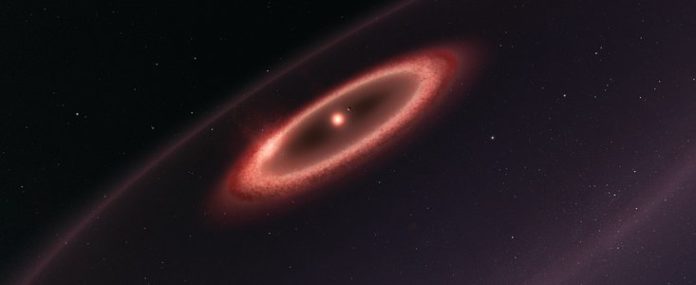Alma observatory in Chile has recently discovered cold dust around the closest star, Proxima Centauri to the Solar System. It suggests that the glow coming from cold dust in a region between one to four times as far from Proxima Centauri as the Earth is from the Sun.
Proxima Centauri is the nearest star to the sun. It is a faint red dwarf lying only four light-years away in the southern heavenly body of Centaurus. Revolved by the closest planet to the Solar System, Proxima b, there is more to this system than just a single planet.
Scientists now revealed about the emissions from clouds of cold cosmic dust surrounding the star in the form of dust belts. Those dust belts are the remaining materials that did not form into larger bodies such as planets. The belts composed of rock and ice that vary in size from the tiniest dust grain up to asteroid-like bodies many kilometers in diameter.
Lead author Guillem Anglada said, “The dust around Proxima is important because, following the discovery of the terrestrial planet Proxima b, it’s the first indication of the presence of an elaborate planetary system, and not just a single planet, around the star closest to our Sun.”
During observation, the dust appears to lie in a belt that extends a few hundred million kilometers from Proxima Centauri. Calculating its mass, scientists found that it is about one-hundredth of the Earth’s mass. In addition, the belt has a temperature of about –230 degrees Celsius, as cold as that of the Kuiper Belt in the outer Solar System.
The data also suggest the there might be another belt with almost 10 times more cold dust. If confirmed, the nature of an outer belt is intriguing, given its very cold environment far from a star that is cooler and fainter than the Sun.
Guillem Anglada said, “This result suggests that Proxima Centauri may have multiple planet systems with a rich history of interactions that resulted in the formation of a dust belt. Further study may also provide information that might point to the locations of as yet unidentified additional planets.”
Co-author Pedro Amado said, “These first results show that ALMA can detect dust structures orbiting around Proxima. Further observations will give us a more detailed picture of Proxima’s planetary system. In combination with the study of protoplanetary discs around young stars, many of the details of the processes that led to the formation of the Earth and the Solar System about 4600 million years ago will be unveiled. What we are seeing now is just the appetizer compared to what is coming!”
